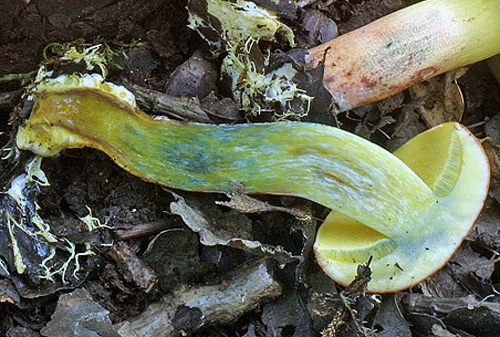Xerocomus Quél.
Recent molecular studies have shown that Xerocomus in its current circumscription is likely an artificial grouping and it is possible that it will be split at some point into smaller genera. Molecular studies also have changed our understanding about the species of xerocomoid boletes showing that morphological features are quite variable in this group. Not only microscopic study is essential for determination, but scanning electron microscope will be often needed in this “genus” as the spore ornamentation is not always seen under ordinary light microscope. Do bear in mind that macroscopic characters, such as colours, cracking cuticle, etc., tend to intergrade between the different species. Note that Boletus impolitus and Boletus depilatus that were shown to be close to Xerocomus subtomentosus and its allies, are here retained in Boletus for practical reasons. The same applies also for Phylloporus pelletieri, placed here in a genus of its own, but being also close to Xerocomus subtomentosus group.
Although large reference list will be found under most of the species, one should always consult Ladurner & Simonini (2003) having in mind that there are some new species (X. chrysonemus, X. marekii, X. silwoodensis) described after this otherwise superior book was printed. Useful keys, covering most of the European xerocomoid boletes (except some southern taxa) are provided by Knudsen & Vesterholt (2008), Hills (2008) and Kibby (2011), the later also featuring an excellent comparison chart.
Fruitbody medium to small sized, boletoid, without veil and ring. Stipe solid, often tapering towars the base. Flesh variously coloured, changing or not when exposed to air. Tubes not separable from each other, instead tearing apart. Pores usually angular.
Xerocomus ripariellus Redeuilh
Description
Cap up to 6 cm, at first hemispherical, later convex to flattened, bright red, carmine, dark red, reddish brown, often with age discolouring to apricot, ochraceous with reddish tint, dry, velvety, often cracked. Stipe cylindrical, ventricose or club-shaped, bright or pale yellow and usually covered mostly in the lower part with very fine red granules, often discolouring with age, blueing when bruised. Tubes pale yellow to yellow with olivaceous tint, blueing when injured. Pores concolorous with the tubes, blueing when bruised. Flesh pale yellow in the cap, pale yellow to yellow in the stipe, often red to vinaceous in the stipe base, blueing when exposed to air. Smell not distinctive. Taste not distinctive. Spores 11–15 × 4–5.5 μm, striate. Pileipellis palisadoderm of septate hyphae of cylindrical, incrusted cells.
Habitat. Wet woodlands, mycorrhizal presumably with poplars (Populus), alders (Alnus), willows (Salix) or oaks (Quercus).
Distribution. Not yet adequately known. So far reported only from Europe. Probably more widespread, but under-recorded.
Similarity. Similar to Xerocomus rubellus which is usually easily distinguished macroscopically on the account of the red dots in the flesh in the stipe base.
A number of other red caped boletes resemble X. ripariellus. These are:
Xerocomus cisalpinus – also having striate spores, but found in different kind of habitats
Xerocomus dryophilus – distinguished by the beetroot red flesh in the lower parts of the stipe and non striate spores
Xerocomus fennicus – distinguished by its truncate and striate spores
Xerocomus marekii – distinguished by its truncate spores
Photographs

A rich collection of typical fruitbodies of Xerocomus ripariellus. (photo G. Eyssartier)

Sectioned fruitbody of Xerocomus ripariellus. The lack of red dots in the stipe base distinguishes this species from X. rubellus. (photo G. Eyssartier)
Important literature
Estadès, A. & Lannoy, G. 2004. Les bolets européens. – Bulletin Mycologique et Botanique Dauphiné-Savoie 44(3): 3–79.
Galli, R. 1998. I Boleti. Atlante pratico-monographico per la determinazione dei boleti. Edinatura, Milano.
Hills, A.E. 2008. The genus Xerocomus. A personal view, with a key to the British species. Field Mycology 9(3): 77–96.
Knudsen, H. & Vesterholt, J. [eds.]. 2008. Funga Nordica. Nordsvamp, Kopenhagen.
Ladurner, H., Pöder, R., Rocabruna, A. & Tabarés, M. 2001. Boletellus catalaunicus Pöder, Moreno, Rocabruna et Tabarés: a synonym of Xerocomus ripariellus Redeuilh. – Revista Catalana de Micologia 23: 121–125. (available online)
Ladurner, H. & Simonini, G. 2003. Xerocomus s.l. – In: Fungi Europaei. Vol. 8. Pp. 1–527. Edizioni Candusso, Alassio.
Lannoy, G. & Estadès, A. 2001. Les Bolets. Flore mycologique d’Europe. Documents Mycologiques Mémoire Hors série no. 6. Pp. 1–163. Association d’Écologie et de Mycologie, Lille.
Oolbekkink G.T. 1991. The taxonomic value of the ornamentation of spores in ‘the Xerocomus-group’ of Boletus. – Persoonia 14: 245–273.
Pöder, R., Moreno, G., Tabarés, M. & Rocabruna, A. 1997. A new Boletellus from Catalonia (Spain). – Mycotaxon 62: 231–237. (available online)
Redeuilh, G. 1997. Xerocomus ripariellus Redeuilh (sp.nov.). – Documents Mycologique 26(104): 30–31.
Schreiner, J. 2000. Xerocomus ripariellus für Deutschland nachgewiesen. – Zeitschrift für Mykologie 66: 151–160.
Šutara, J., Mikšík, M. & Janda, V. 2009. Hřibovité houby. Čeled’ Boletaceae a rody Gyrodon, Gyroporus, Boletinus a Suillus. Academia, Praha.
Watling, R. & Hills, A.E. 2005. Boletes and their allies (revised and enlarged edition). – In: Henderson, D.M., Orton, P.D. & Watling, R. [eds]. British Fungus Flora. Agarics and boleti. Vol. 1. Royal Botanic Garden, Edinburgh.